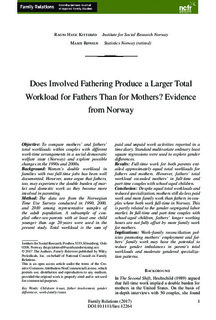| dc.contributor.author | Kitterød, Ragni Hege | |
| dc.contributor.author | Rønsen, Marit | |
| dc.date.accessioned | 2017-11-02T09:13:17Z | |
| dc.date.available | 2017-11-02T09:13:17Z | |
| dc.date.created | 2017-11-01T10:30:02Z | |
| dc.date.issued | 2017 | |
| dc.identifier.citation | Family Relations. 2017, . | |
| dc.identifier.issn | 0197-6664 | |
| dc.identifier.uri | http://hdl.handle.net/11250/2463631 | |
| dc.description.abstract | Objective: To compare mothers’ and fathers’total workloads within couples with different work-time arrangements in a social democratic welfare state (Norway) and explore possible changes in the 1990s and 2000s. Background: Women’s double workload in families with two full-time jobs has been well documented. However, some argue that fathers,too, may experience the double burden of market and domestic work as they become more involved in parenting. Method: The data are from the Norwegian Time Use Surveys conducted in 1990, 2000,and 2010 among representative samples of the adult population. A subsample of coupled other-sex-parents with at least one child younger than age 20 years were used in the present study. Total workload is the sum of paid and unpaid work activities reported in a time diary. Standard multivariate ordinary least square regressions were used to explore gender differences. Results: Full-time work for both parents entailed approximately equal total workloads for fathers and mothers. However, fathers’ total workload exceeded mothers’ in full-time and part-time couples with school-aged children. Conclusion: Despite equal total workloads and reduced specialization, mothers still do less paid work and more family work than fathers in couples where both work full-time in Norway. This is partly related to the gender-segregated labor market. In full-time and part-time couples With school-aged children, fathers’ longer working hours are not fully offset by more family work for mothers. Implications: Work–family reconciliation policies promoting mothers’ employment and fathers’ family work may have the potential to reduce gender imbalances in parent’s total workloads and moderate gendered specialization patterns. | |
| dc.language.iso | eng | |
| dc.title | Does Involved Fathering Produce a Larger Total Workload for Fathers Than for Mothers? Evidence from Norway | |
| dc.type | Peer reviewed | |
| dc.type | Journal article | |
| dc.description.version | publishedVersion | |
| dc.source.pagenumber | 16 | |
| dc.source.journal | Family Relations | |
| dc.identifier.doi | 10.1111/fare.12264 | |
| dc.identifier.cristin | 1509643 | |
| dc.relation.project | Norges forskningsråd: 236926 | |
| dc.relation.project | Norges forskningsråd: 236770 | |
| cristin.unitcode | 7437,0,0,0 | |
| cristin.unitname | Institutt for samfunnsforskning | |
| cristin.ispublished | true | |
| cristin.fulltext | original | |
| cristin.qualitycode | 1 | |
